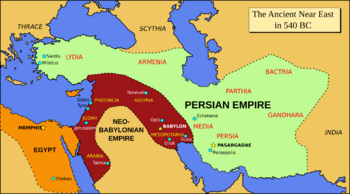Late Period of ancient Egypt facts for kids
Quick facts for kids
Late Period of ancient Egypt
|
|||||||||||
|---|---|---|---|---|---|---|---|---|---|---|---|
| c. 664 BC–c. 332 BC | |||||||||||

Egypt in the 6th century BC.
|
|||||||||||
| Capital | Sais, Mendes, Sebennytos | ||||||||||
| Common languages | Ancient Egyptian | ||||||||||
| Religion | Ancient Egyptian religion | ||||||||||
| Government | Monarchy | ||||||||||
| Pharaoh | |||||||||||
|
• c. 664–610 BC
|
Psamtik I (first) | ||||||||||
|
• 336–332 BC
|
Darius III (last) | ||||||||||
| History | |||||||||||
|
• Began
|
c. 664 BC | ||||||||||
|
• Ended
|
c. 332 BC | ||||||||||
|
|||||||||||
The Late Period of ancient Egypt was a time when native Egyptian rulers were in charge after a period of foreign rule. It started around 664 BC and lasted until 332 BC. This era began with the 26th Saite Dynasty, founded by Psamtik I.
Before this, Egypt was ruled by the Nubian 25th Dynasty. Psamtik I first ruled as a vassal, meaning he was under the control of the Neo-Assyrians. The Late Period also includes times when the Persian Empire ruled Egypt.
This period ended when Alexander the Great conquered the Persian Empire. One of his generals, Ptolemy I Soter, then started the Ptolemaic dynasty. This began the age of Hellenistic Egypt, where Greek culture became very important.
Contents
History of the Late Period
The 26th Dynasty: Saite Rulers
The Twenty-Sixth Dynasty is also called the Saite Dynasty. This is because its main city was Sais. This dynasty ruled from 672 BC to 525 BC and had six pharaohs.
It began when Psamtik I united Egypt around 656 BC. This happened after the Assyrians attacked Thebes in 663 BC. During this time, Egyptians started building a canal from the Nile River to the Red Sea.
Egypt also became stronger in the Near East. They conquered the city of Ashdod around 655 BC. Egyptian items found in other lands show that Egypt had control there. Their influence even reached the Euphrates River. However, they were later pushed back after the Battle of Carchemish.
Amasis II became pharaoh and focused on building ties with the Greek world. He even took control of Cyprus. To the south, Psamtik II led a big army into Nubia and defeated them.
One important discovery from this time is the Brooklyn Papyrus. This ancient medical text contains remedies for snakebites. It describes different treatments based on the type of snake or symptoms.
Artwork from this period often showed animal cults and animal mummies. For example, there's an image of the god Pataikos. He wears a scarab beetle and holds snakes. He stands on crocodiles, showing the importance of animals in their beliefs.
The 27th Dynasty: Persian Rule Begins
The First Achaemenid Period started in 525 BC. This is when the powerful Achaemenid Empire (the Persian Empire) conquered Egypt. This happened after the Battle of Pelusium. Egypt then became a "satrapy," which means it was a province ruled by a Persian governor.
The Twenty-seventh Dynasty of Egypt includes the Persian emperors who ruled Egypt as pharaohs. These included Cambyses II, Xerxes I, and Darius the Great. They ruled through their governors. Some Egyptians, like Petubastis III, tried to rebel against Persian rule. The Athenians also helped in a revolt led by Inaros II, but it failed.
Native Egyptian Dynasties Return (28th–30th)
The Twenty-Eighth Dynasty had only one king, Amyrtaeus. He successfully rebelled against the Persians. This brought back a short time of independence for Egypt under native rulers. This dynasty lasted for six years, from 404 BC to 398 BC.
The Twenty-Ninth Dynasty ruled from the city of Mendes. They ruled from 398 BC to 380 BC. King Hakor of this dynasty managed to defeat a Persian invasion.
The Thirtieth Dynasty continued the artistic style of the 26th Dynasty. Three pharaohs ruled from 380 BC to 343 BC. The first king, Nectanebo I, defeated another Persian invasion in 373 BC. His successor, Teos, led an army against the Persian Empire in the Near East.
However, Teos's brother, Tjahapimu, plotted against him. Tjahapimu convinced his son, Nectanebo II, to become pharaoh instead. Teos had to flee, and his army fell apart. Nectanebo II was the last native Egyptian ruler. He was defeated in battle, and Egypt was taken over by the Persian Empire again.
The 31st Dynasty: Persian Rule Returns
The Second Achaemenid Period began when Egypt became a Persian province again. This was under the rule of the Thirty-First Dynasty (343–332 BC). This dynasty included three Persian emperors who ruled as pharaohs: Artaxerxes III, Artaxerxes IV, and Darius III. There was a brief revolt by Khababash during this time.
Persian rule in Egypt ended when Alexander the Great defeated the Achaemenid Empire. Alexander accepted the surrender of the Persian governor of Egypt in 332 BC. This marked the beginning of Greek rule in Egypt, which later became the Ptolemaic Kingdom after Alexander's death.

